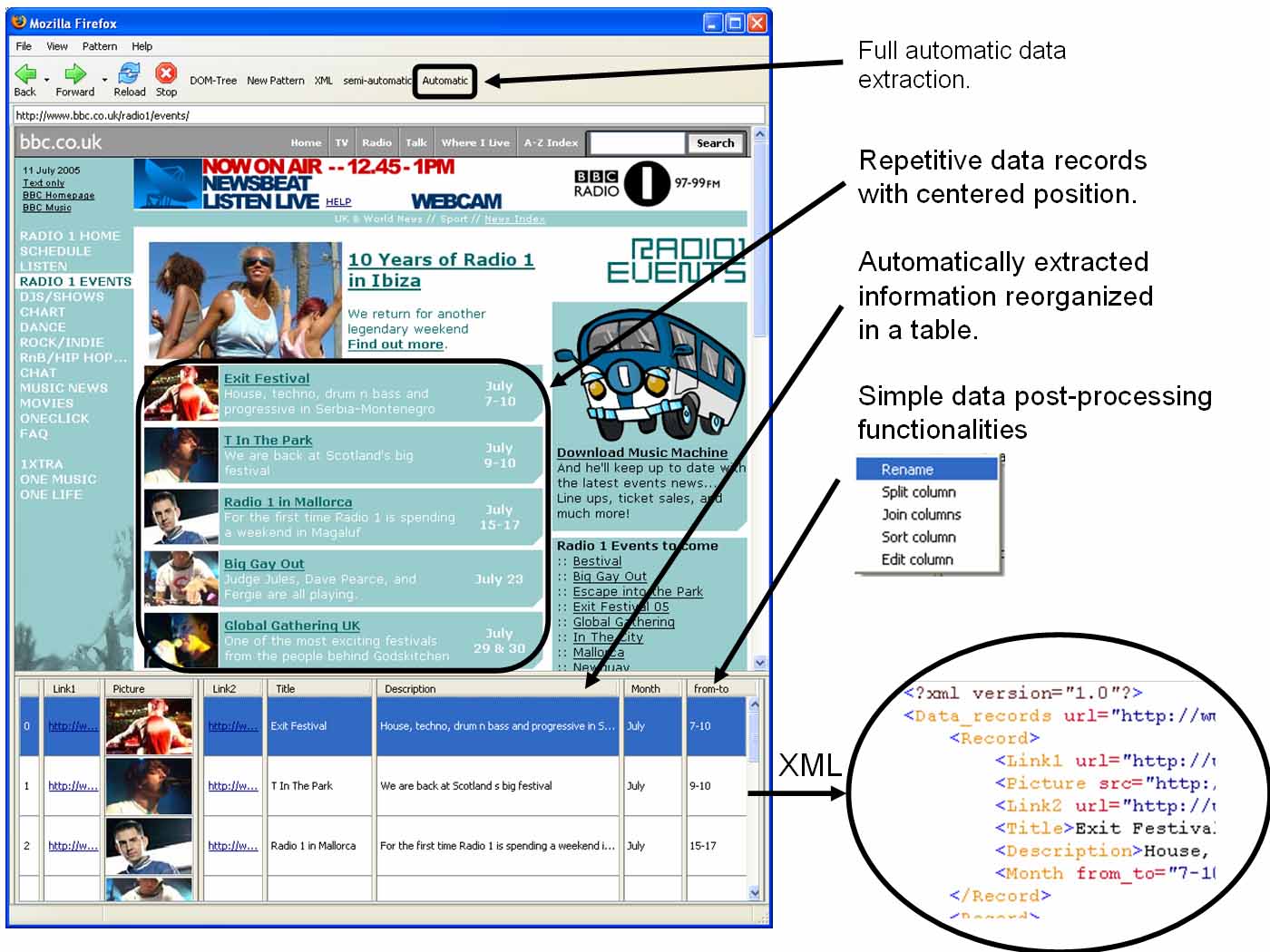|
|
|
Automatic Web Data Extraction for Information Monitoring
Overview
Rife information content available on the
World Wide Web is published
within representation-oriented semi-structured HTML pages making it
difficult for machines to access the content automatically. Therefore tools which
are able to unfold the information contained in suchlike resources and transform
them into machine-readable and understandable formats are required.
As the vision of the Sematic Web seems to be far away from beeing
accomplished, due to the lack of
simple mechanisms, we propose a fully automatic wrapper
prototype called ViPER (Visual perception-based extraction of records)
which is able to extract repetitive structured data records contained
in HTML pages with high precision and recall. ViPER tries to
identifiy repetitive structures
contained in the HTML source code and finally weights and separates the
patterns according to the 2D-layout information
according to the rendering information of the browser. After the
extraction
process the pattern with the highest weight becomes
aligned in a table, handy to post-process the data.
By mapping the data into a structured format, machines are finally able
to process the relevant content automatically.
The ViPER system itself has been developed on top of JREX, which enables user to access Mozilla's XPCOM interface
within Java. As ViPER is integrated
into a meta search engine environment called ASTRO, we are currently
working on a plugin-prototype of the system which enables a user to
take advantage of the extraction power of ViPER during Web browsing
within Mozilla or Firefox.
The ViPER-plugin for example enables a user to easily generate an agent
which monitors a dynamic Web page and sends a notification as soon as
the price of an item drops below a certain limit. Where the number of
online stores monitored by the agent is not limited.
A sample snapshot of the plugin, demonstrating the automatic extracting
functionality applied to a Web site containing
repetitive data records, is shown below. In the future we plan to
make the plugin freely available for others.

If you like to see further snapshots made during the use of
the ViPER plugin take a look at these pictures 1
2
3.
ViPER uses several novel techniques to extract relevant information
from dynamic Web Sites. Hereby most of the algorithms for the pattern
detection and alignment procedure come from the bioinformatics domain.
In order to demonstrate that our approach is able to extract repetitive
data records with high precision and recall we compared our system with
current state-of-the art systems on several third party data sets with
very good results.
|
Data Set 2
[1]
|
Data Set 3
[1]
|
TBDW Ver. 1.02
[2]
|
extraction systems
(Asterisk marks results
reported in [1])
|
ViNTs*
[1]
|
ViPER
|
ViNTs*
|
MDR*
[3]
|
ViPER
|
ViNTs
|
ViPER
|
#search engines
|
100 |
42 |
51 |
#pages per search engine
|
5
|
1
|
1 |
1 |
#Search
Result Records
|
6905
|
1390
|
795 |
693 |
#SRRs extracted
|
6872
|
1419
|
795
|
479
|
790
|
661
|
686
|
#SRRs correct
|
6740
|
1378
|
785
|
420
|
779
|
618
|
676
|
Recall
|
97.6%
|
99.1%
|
98.7%
|
52.8%
|
98.0%
|
89.2%
|
97.6%
|
Precision
|
98.1%
|
97.1%
|
98.7%
|
87.7%
|
98.6%
|
93.5%
|
98.5%
|
| [1] |
W. Meng, V. Raghavan, and C. Yu. Fully automatic wrapper generation for search engines.
In WWW14, May 2005.
|
| [2] |
Y. Yamada, N. Craswell, T. Nakatoh, and S. Hirokawa. Testbed for
information extraction from deep web. In WWW Alt.’04, pages 346–347, New York, NY, USA, 2004. ACM Press
|
| [3] |
B. Liu, R. Grossman, and Y. Zhai. Mining data records in web pages. In SIGKDD’03, 2003.
|
|
|
Publications
The following list identifies papers published in prestigious
conferences that are relevant for the project. Please feel free to make
inquiries in order to obtain most recent, still unpublished work.
|
Project Members
|
|

